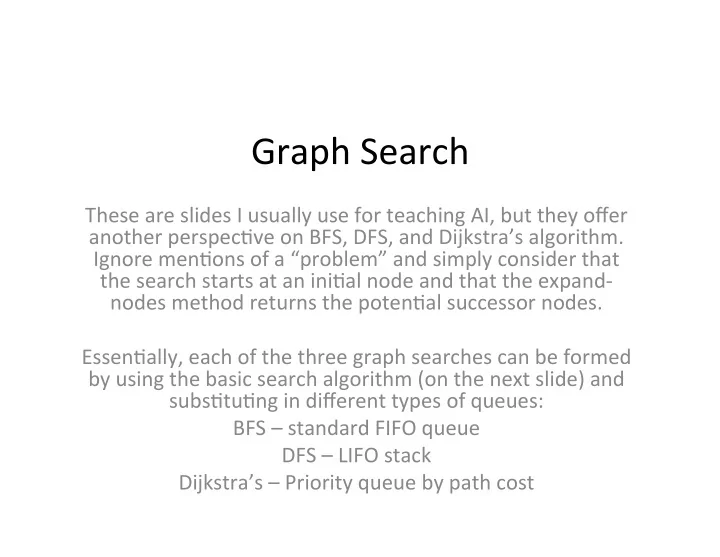

Graph ¡Search ¡ These ¡are ¡slides ¡I ¡usually ¡use ¡for ¡teaching ¡AI, ¡but ¡they ¡offer ¡ another ¡perspec;ve ¡on ¡BFS, ¡DFS, ¡and ¡Dijkstra’s ¡algorithm. ¡ ¡ Ignore ¡men;ons ¡of ¡a ¡“problem” ¡and ¡simply ¡consider ¡that ¡ the ¡search ¡starts ¡at ¡an ¡ini;al ¡node ¡and ¡that ¡the ¡expand-‑ nodes ¡method ¡returns ¡the ¡poten;al ¡successor ¡nodes. ¡ ¡ Essen;ally, ¡each ¡of ¡the ¡three ¡graph ¡searches ¡can ¡be ¡formed ¡ by ¡using ¡the ¡basic ¡search ¡algorithm ¡(on ¡the ¡next ¡slide) ¡and ¡ subs;tu;ng ¡in ¡different ¡types ¡of ¡queues: ¡ BFS ¡– ¡standard ¡FIFO ¡queue ¡ DFS ¡– ¡LIFO ¡stack ¡ Dijkstra’s ¡– ¡Priority ¡queue ¡by ¡path ¡cost ¡
State-‑space ¡search ¡algorithm ¡ function general-search (problem, QUEUEING-FUNCTION) ;; ¡problem ¡describes ¡the ¡start ¡state, ¡operators, ¡goal ¡test, ¡and ¡operator ¡costs ¡ ;; ¡queueing-‑func;on ¡is ¡a ¡comparator ¡func;on ¡that ¡ranks ¡two ¡states ¡ ;; ¡general-‑search ¡returns ¡either ¡a ¡goal ¡node ¡or ¡ failure ¡ nodes = MAKE-QUEUE(MAKE-NODE(problem.INITIAL-STATE)) loop if EMPTY(nodes) then return "failure" node = REMOVE-FRONT(nodes) if problem.GOAL-TEST(node.STATE) succeeds then return node nodes = QUEUEING-FUNCTION(nodes, EXPAND(node, problem.OPERATORS)) end ¡ ¡ ¡ ¡ ¡;; ¡Note: ¡The ¡goal ¡test ¡is ¡NOT ¡done ¡when ¡nodes ¡are ¡generated ¡ ¡ ¡ ¡ ¡ ¡;; ¡Note: ¡This ¡algorithm ¡does ¡not ¡detect ¡loops
Key ¡procedures ¡to ¡be ¡defined ¡ • EXPAND ¡ – Generate ¡all ¡successor ¡nodes ¡of ¡a ¡given ¡node ¡ • GOAL-‑TEST ¡ – Test ¡if ¡state ¡sa;sfies ¡all ¡goal ¡condi;ons ¡ • QUEUEING-‑FUNCTION ¡ – Used ¡to ¡maintain ¡a ¡ranked ¡list ¡of ¡nodes ¡that ¡are ¡ candidates ¡for ¡expansion ¡
Evalua;ng ¡Search ¡Strategies ¡ • Completeness ¡ – Guarantees ¡finding ¡a ¡solu;on ¡whenever ¡one ¡exists ¡ • Time ¡complexity ¡ – How ¡long ¡(worst ¡or ¡average ¡case) ¡does ¡it ¡take ¡to ¡find ¡a ¡solu;on? ¡ Usually ¡measured ¡in ¡terms ¡of ¡the ¡number ¡of ¡nodes ¡expanded ¡ • Space ¡complexity ¡ – How ¡much ¡space ¡is ¡used ¡by ¡the ¡algorithm? ¡Usually ¡measured ¡in ¡ terms ¡of ¡the ¡maximum ¡size ¡of ¡the ¡ “ nodes ” ¡list ¡during ¡the ¡search ¡ • Op3mality/Admissibility ¡ – If ¡a ¡solu;on ¡is ¡found, ¡is ¡it ¡guaranteed ¡to ¡be ¡an ¡op;mal ¡one? ¡ That ¡is, ¡is ¡it ¡the ¡one ¡with ¡minimum ¡cost? ¡
Example ¡for ¡illustra;ng ¡uninformed ¡search ¡strategies ¡ S ¡ 8 ¡ 3 ¡ 1 ¡ A ¡ B ¡ C ¡ 3 ¡ 15 ¡ 7 ¡ 20 ¡ 5 ¡ D ¡ E ¡ G ¡
Breadth-‑First ¡ Enqueue ¡nodes ¡in ¡ FIFO ¡(first-‑in, ¡first-‑out) ¡order. ¡ ¡ • Complete ¡ ¡ • Op3mal ¡(i.e., ¡admissible) ¡if ¡all ¡operators ¡have ¡the ¡same ¡cost. ¡Otherwise, ¡not ¡ • op;mal ¡but ¡finds ¡solu;on ¡with ¡shortest ¡path ¡length. ¡ ¡ Exponen3al ¡3me ¡and ¡space ¡complexity , ¡O(b d ), ¡where ¡d ¡is ¡the ¡depth ¡of ¡the ¡ • solu;on ¡and ¡b ¡is ¡the ¡branching ¡factor ¡(i.e., ¡number ¡of ¡children) ¡at ¡each ¡node ¡ ¡ Will ¡take ¡a ¡ long ¡3me ¡to ¡find ¡solu3ons ¡with ¡a ¡large ¡number ¡of ¡steps ¡because ¡ • must ¡look ¡at ¡all ¡shorter ¡length ¡possibili;es ¡first ¡ ¡ – A ¡complete ¡search ¡tree ¡of ¡depth ¡d ¡where ¡each ¡non-‑leaf ¡node ¡has ¡b ¡children, ¡has ¡a ¡ total ¡of ¡1 ¡+ ¡b ¡+ ¡b 2 ¡+ ¡... ¡+ ¡b d ¡= ¡(b (d+1) ¡-‑ ¡1)/(b-‑1) ¡nodes ¡ ¡ – For ¡a ¡complete ¡search ¡tree ¡of ¡depth ¡12, ¡where ¡every ¡node ¡at ¡depths ¡0, ¡..., ¡11 ¡has ¡10 ¡ children ¡and ¡every ¡node ¡at ¡depth ¡12 ¡has ¡0 ¡children, ¡there ¡are ¡1 ¡+ ¡10 ¡+ ¡100 ¡+ ¡1000 ¡+ ¡... ¡ + ¡10 12 ¡= ¡(10 13 ¡-‑ ¡1)/9 ¡= ¡O(10 12 ) ¡nodes ¡in ¡the ¡complete ¡search ¡tree. ¡If ¡BFS ¡expands ¡1000 ¡ nodes/sec ¡and ¡each ¡node ¡uses ¡100 ¡bytes ¡of ¡storage, ¡then ¡BFS ¡will ¡take ¡35 ¡years ¡to ¡ run ¡in ¡the ¡worst ¡case, ¡and ¡it ¡will ¡use ¡111 ¡terabytes ¡of ¡memory! ¡
¡Depth-‑First ¡(DFS) ¡ • Enqueue ¡nodes ¡in ¡ LIFO ¡(last-‑in, ¡first-‑out) ¡order. ¡That ¡is, ¡use ¡a ¡ stack ¡data ¡structure ¡to ¡order ¡nodes. ¡ ¡ • May ¡not ¡terminate ¡without ¡a ¡ “ depth ¡bound, ” ¡i.e., ¡cuing ¡off ¡ search ¡below ¡a ¡fixed ¡depth ¡D ¡( ¡ “ depth-‑limited ¡search ” ) ¡ • Not ¡complete ¡(with ¡or ¡without ¡cycle ¡detec;on, ¡and ¡with ¡or ¡ without ¡a ¡cutoff ¡depth) ¡ ¡ • Exponen3al ¡3me , ¡O(b d ), ¡but ¡only ¡ linear ¡space , ¡O(bd) ¡ • Can ¡find ¡ long ¡solu3ons ¡quickly ¡if ¡lucky ¡(and ¡ short ¡solu3ons ¡ slowly ¡if ¡unlucky!) ¡ • When ¡search ¡hits ¡a ¡dead-‑end, ¡can ¡only ¡back ¡up ¡one ¡level ¡at ¡a ¡ ;me ¡even ¡if ¡the ¡ “ problem ” ¡occurs ¡because ¡of ¡a ¡bad ¡operator ¡ choice ¡near ¡the ¡top ¡of ¡the ¡tree. ¡Hence, ¡only ¡does ¡ “ chronological ¡backtracking ” ¡
Uniform-‑Cost ¡(UCS) ¡ • Enqueue ¡nodes ¡by ¡ path ¡cost . ¡That ¡is, ¡let ¡g(n) ¡= ¡cost ¡of ¡the ¡path ¡ from ¡the ¡start ¡node ¡to ¡the ¡current ¡node ¡n. ¡Sort ¡nodes ¡by ¡ increasing ¡value ¡of ¡g. ¡ ¡ • Called ¡ “ Dijkstra ’ s ¡Algorithm ” ¡in ¡the ¡algorithms ¡literature ¡and ¡ similar ¡to ¡ “ Branch ¡and ¡Bound ¡Algorithm ” ¡in ¡opera;ons ¡ research ¡literature ¡ ¡ • Complete ¡(*) ¡ • Op3mal/Admissible ¡(*) ¡ • Admissibility ¡depends ¡on ¡the ¡goal ¡test ¡being ¡applied ¡ when ¡a ¡ node ¡is ¡removed ¡from ¡the ¡nodes ¡list , ¡not ¡when ¡its ¡parent ¡node ¡ is ¡expanded ¡and ¡the ¡node ¡is ¡first ¡generated ¡ ¡ • Exponen3al ¡3me ¡and ¡space ¡complexity , ¡O(b d ) ¡ ¡
Recommend
More recommend